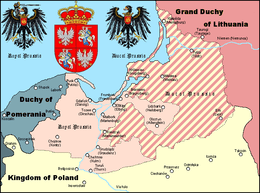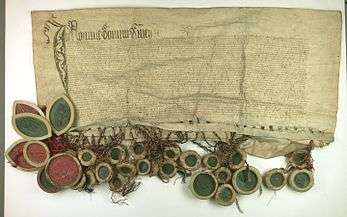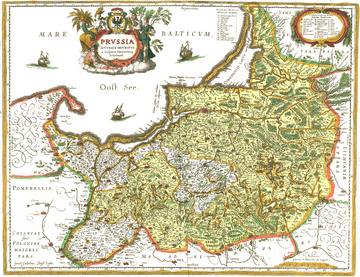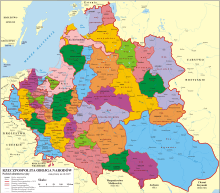Royal Prussia
| Royal Prussia Prusy Królewskie (pl) Königlich-Preußen (de) Prussia Regalis (la) | ||||||
| Province of the Kingdom of Poland (Polish-Lithuanian Commonwealth from 1569) | ||||||
| ||||||
| ||||||
 | ||||||
| History | ||||||
| • | Established | 19 October 1466 | ||||
| • | Annexed | 5 August 1772 | ||||

Royal Prussia (Polish: Prusy Królewskie; German: Königlich-Preußen or Preußen Königlichen Anteils) or Polish Prussia[1] (Polish: Prusy Polskie;[2] German: Polnisch-Preußen[3]) was a region (part of the province of Greater Poland) of the Polish-Lithuanian Commonwealth that was carved out of the State of the Teutonic Order. It consisted of the following districts: Pomerelia (Gdańsk Pomerania) with Danzig (Gdańsk), Chełmno Land (Kulmerland) with Michałów Land (Michelauer land) and Toruń (Thorn), the mouth of the Vistula with Elbląg (Elbing) and Malbork (Marienburg), the Bishopric of Warmia (Ermland) with Olsztyn (Allenstein ). By the Second Peace of Thorn (1466), these districts were ceded to the Kingdom of Poland.[4] Until the 1569 Union of Lublin the region enjoyed a substantial autonomy. After 1569, Royal Prussia was directly administered by the Crown of the Kingdom of Poland in the Polish-Lithuanian Commonwealth.
Administratively Royal Prussia was part of the Greater Poland Province together with Greater Poland proper, Masovia, and Łęczyca Voivodeship and Sieradz Voivodeship, with the Province capital being Poznań.[1]
Geography
From the 14th century, in old texts (until the 16th or 17th century) and in Latin, the terms Prut(h)enia and Prut(h)enic refer not only to the original settlement area of the extinct Old Prussians (Prusowie, see: Prussia) along the Baltic Coast east of the Vistula River, but also to the adjacent lands of the former Samboride dukes of Pomerelia, which the Teutonic Knights had acquired from Poland in the 1343 Treaty of Kalisz and added to their Order's State.

Polish Prussia established in 1466 included these western parts of Teutonic Prussia, i.e. the Pomerelian lands with the port of Danzig (Gdańsk Pomerania), as well as Chełmno Land (Kulmerland) with Michelauer land (Michałowo Land) and Toruń in the south, but also the area around Marienburg and Elbing and the episcopal lands of Warmia. The former Pomerelian Lauenburg and Bütow Land in the far west was held by the Pomeranian dukes as a Polish fief.
Royal Prussia is distinguished from later Ducal Prussia, the remaining parts of Prussia around Königsberg (Królewiec), which was a fiefdom under Polish suzerainty, first held by the Teutonic Knights, from 1525 by secular dukes of the Hohenzollern dynasty. From 1618 this part was held in personal union by the Electors of Brandenburg (Brandenburg-Prussia) and in 1657 reached full sovereignty from the Polish Crown according to the Treaty of Wehlau.
History
Before 1308 the Pomerelian part of the region, with Gdańsk, was part of the first Polish state, enjoying periods of autonomy and independence. During the rule of Władysław I the Elbow-high of Poland, the Margraviate of Brandenburg staked its claim on the territory in 1308, leading Władysław to request assistance from the Teutonic Knights, who evicted the Brandenburgers but took the area for themselves; they annexed it and incorporated it into the Teutonic Order state in 1309 (Teutonic takeover of Danzig (Gdańsk) and Treaty of Soldin (Myślibórz)). This event caused a long-lasting dispute between Poland and the Teutonic Order over the control of Pomerelia. It resulted in a series of Polish–Teutonic Wars throughout 14th and 15th centuries.
After their defeat at the Battle of Grunwald, the Teutonic Knights according to the 1411 Peace of Thorn had to pay large contributions to the Polish kings, which strongly affected the public budget. In view of rising taxes, several local nobles and Hanseatic cities in 1440 established the Prussian Confederation at Marienwerder (Kwidzyn) protesting against the Order's internal and financial policies. The Confederation was led by the citizens of Danzig, Elbing, and Thorn. The gentry from Chełmno Land and Pomerelia participated as well. Grand Master Ludwig von Erlichshausen demanded the dissolution and in 1453 searched for help from Pope Nicholas V and Emperor Frederick III. In turn, in February 1454, the Confederation sent a delegation, under Johannes von Baysen, to King Casimir IV Jagiellon of Poland, to ask him for support against the Teutonic Order's rule and for incorporation of their homeland into the Kingdom of Poland. In this act, Prussian delegates declared the Polish king the only true heir of those lands, parts of which were earlier illegally separated from Poland. After some hesitation and negotiating the exact conditions of incorporation on 6 March 1454, the Royal Chancellery issued the Act of Incorporation that met the requests of the Prussian estates represented by the Confederation.[5]
Prussian–Polish Alliance
After the Prussian Confederation pledged allegiance to Casimir on 6 March 1454, the Thirteen Years' War ("War of the Cities") began. King Casimir IV Jagiellon appointed Baysen as the first war-time governor of Royal Prussia. On 28 May 1454 the king took an oath of allegiance from the citizens of Toruń and in June a similar oath from the citizens of Elbing and Königsberg.[5]
The rebellion also included major cities from the eastern part of the Order's lands, such as Kneiphof (Knipawa), later a part of Königsberg. Though the Knights were victorious at the 1454 Battle of Chojnice, they were not able to finance further mercenaries in order to reconquer the castles occupied by the insurgents. Thirteen years of attrition warfare ended in October 1466 with the Second Peace of Toruń, which provided for the Order's cession to the Polish Crown of its rights over the western half of Prussia, including Pomerelia and the districts of Elbing, Marienburg, and Chełmno.
Polish Crown

According to the 1454 Incorporation Statute issued by King Casimir IV, Royal Prussia enjoyed substantial autonomy as part of the Crown of Poland: it had its own treasury, monetary unit, and armies. It was governed by a council, subordinate to the Polish king, whose members were chosen from local lords and wealthy citizens (ius indigenatus). Prussians had also seats provided for them in Polish Diet, but they chose not to use this right until the Union of Lublin. Toruń, Elbing, and Danzig (Danzig law) gained privileges similar to the status of a Free imperial city.
The Bishop of Warmia had claimed Imperial Prince-Bishopric status, as mentioned in the Golden Bull of 1356 by Emperor Charles IV. Although the area was never directly under the Emperor's jurisdiction and the claim seems unsupported by any bestowal document, it was in wide use in the 17th century. The bishopric continued defending this status until the end of the Holy Roman Empire in 1806.
The eastern part of Prussia remained under the rule of the Teutonic Knights and its successors as a fief of Poland, becoming the Ducal Prussia in 1525 when the Order's last Grand Master, Albert von Hohenzollern, adopted Lutheranism and secularized the land as its hereditary ruler. In 1618 the duchy was inherited by John Sigismund von Hohenzollern. It remained under Polish (and briefly Swedish) suzerainty and the rulers of Brandenburg had to swear – in the role as Prussian duke – formal allegiance to the Polish Crown. The dukes, in personal union electors of Brandenburg (vassals to the Holy Roman Emperor), achieved sovereignty for the duchy in the Treaty of Wehlau (1657).
Commonwealth administration
  History of Brandenburg and Prussia | |||
| Northern March pre–12th century |
Old Prussians pre–13th century | ||
| Margraviate of Brandenburg 1157–1618 (1806) |
Teutonic Order 1224–1525 | ||
| Duchy of Prussia 1525–1618 |
Royal (Polish) Prussia 1466–1772 | ||
| Brandenburg-Prussia 1618–1701 | |||
| Kingdom in Prussia 1701–1772 | |||
| Kingdom of Prussia 1772–1918 | |||
| Free State of Prussia 1918–1947 |
Klaipėda Region (Lithuania) 1920–1939 / 1945–present | ||
| Brandenburg (Germany) 1947–1952 / 1990–present |
Recovered Territories (Poland) 1918/1945–present |
Kaliningrad Oblast (Russia) 1945–present | |
As a result of the Union of Lublin in 1569, Royal Prussia's autonomy was abolished and the region was united with the Polish Crown. Prussian electors became senators and representatives to the Polish parliament, the Sejm. The region became part of the Greater Poland Province (prowincja wielkopolska) together with the former duchies of Greater Poland and Masovia, with the province capital at Poznań. The Prince-Bishopric of Warmia retained a certain grade of autonomy as a Polish protectorate.
After the incorporation to the Crown of the Polish Kingdom, local diets (Sejmik) were organised for:
- Chełmno Voivodeship with seat in Radzyń,
- Malbork Voivodeship with seat in Sztum and
- for following powiats of Pomeranian Voivodeship:
- Powiat Człuchów with seat in Człuchów or Chojnice,
- Powiat Mirachowo with seat in Mirachowo,
- Powiat Puck with seat in Puck,
- Powiat Świecie with seat in Świecie,
- Powiat Tczew and Powiat Gdańsk with seat in Starogard Gdański,
- Powiat Tuchola with seat in Tuchola.
The main task of the Sejmiks was the election of MPs for the Sejm of Poland. Royal Prussia was allocated 10 MPs (167 total).
The Partitions
During the 1772 First Partition of Poland, the bulk of Royal Prussia was annexed by the Kingdom of Prussia, apart from the areas around the cities of Danzig and Toruń. The Kingdom of Prussia annexed the remaining parts of Royal Prussia controlled by the Polish-Lithuanian Commonwealth in the 1793 Second Partition of Poland. Its territory largely made up the Province of West Prussia created in 1773.
Governors
- 1454–1459: Johannes von Baysen, war-time governor
- 1459–1480: Stibor (Tiburcius) von Baysen[6]
- 1480: Niklas von Baysen, who was only elected; he refused to swear allegiance to the king. He was also Voivode of Malbork.
In 1510, after several attempts to install another governor, the office was abolished.
See also
- History of Poland
- Duchy of Prussia
- Kingdom of Prussia
- Pomerelia
- Kursenieki
- Kashubia
- Warmia
- The plague during the Great Northern War
References
- 1 2 Anton Friedrich Büsching, Patrick Murdoch. A New System of Geography, London 1762, p. 588
- ↑ Zygmunt Gloger (1900). "Volume 325". In Harvard Slavic humanities preservation microfilm project. Geografia historyczna ziem dawnej polski (Historical Geography of the former Polish lands) (in Polish). Wydawnictwo Polska. pp. 82, 144.
- ↑ (German) Polnisch-Preußen ("State Constitution of Polish-Prussia") (see: Excerpt in the publication of 1764, p. 581)
- ↑ Stone, Daniel. A History of East Central Europe. University of Washington Press, 2001, ISBN 0-295-98093-1. p. 30
- 1 2 F. Kiryk, B. Ryś (red.) Wielka Historia Polski, t. II 1320-1506, Kraków 1997, p. 160-161
- ↑ Acten der Ständetage Preussens unter der Herrschaft des Deutschen Ordens: 5 vols., Max Toeppen (ed.), Leipzig: Duncker & Humblot, 1874–1886; reprint Aalen: Scientia, 1968–1974, vol. 5: 'Die Jahre 1458–1525', 1974. p. 90]. ISBN 3-511-02940-6.
Further reading
- Karin Friedrich, The Other Prussia: Royal Prussia, Poland and Liberty, 1569–1772, Cambridge University Press, 2000, ISBN 0-521-58335-7 on Google Books
- Gerard Labuda (ed.), Historia Pomorza, vol. I–IV, Poznań 1969–2003 (also covers East Prussia) (Polish)
- W. Odyniec, Dzieje Prus Królewskich (1454–1772). Zarys monograficzny, Warszawa 1972 (Polish)
- Dzieje Pomorza Nadwiślańskiego od VII wieku do 1945 roku, Gdańsk 1978 (Polish)
_Lob.svg.png)
_Lob.svg.png)
